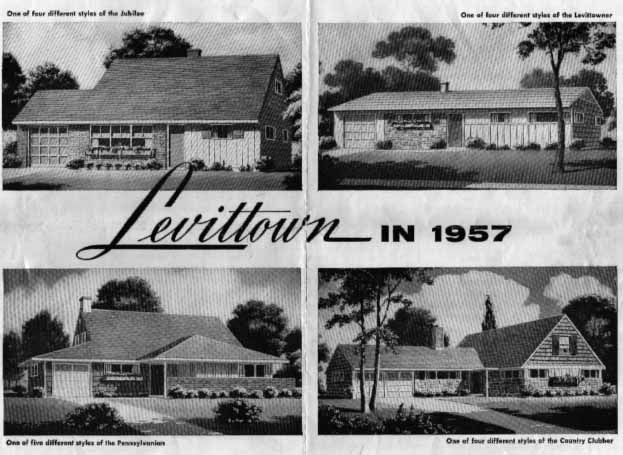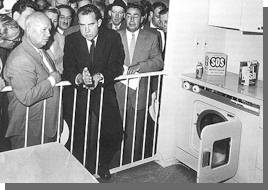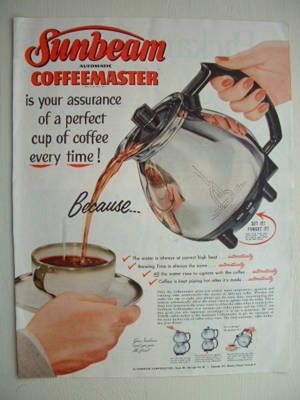Today, Levittown is a model of diversity, McDonald’s promotes
salads, Kay Thompson’s Eloise turns Disney in a TV movie,
Ford reissues the Thunderbird, and Playboy celebrates its fifty-year
anniversary in good taste. The Senate exhumes McCarthy’s
papers, Elvis impersonators roam wild, Ozzy Osbourne and family
replace Ozzie and Harriet, American Idol replaces The
Ed Sullivan Show, and the Mr. Rogers era is sadly over. With
each nostalgic tribute, reissue, and revision of a bygone era,
the American 1950s looms ever larger than life. The images of
this era are icons of American prosperity and success, particularly
within the context of the home. After all, some of the most significant
events of the 1950s occurred literally in the home, broadcasted
into each family room, living room, or den across the nation.
The living room, to be sure, was a weighted locale—developers
and architects as diverse and as diametrically opposite as William
Levitt and Frank Lloyd Wright marketed their home designs with
emphasis on the central living space, on togetherness.
But let us walk out of the living room, Mr. Rogers’ semi-public
domain, into a seemingly benign space, the American kitchen. The
kitchen can be seen as epitomizing the sacred sustenance of the
family unit. But it can also be considered as the most political
space in the entire home—itself a microcosm of society—in
its relevance to social function and its aesthetics of creation,
preservation, and waste. This paper traces the physical development
of the American kitchen, the significant role of the kitchen in
national and international politics, and the portrayal of kitchens
in various examples of period literature. Ironically, but not
surprisingly, more than just a repository for Jell-O molds and
Lipton’s onion dip, the 1950s kitchen plays a significant
role on both private and public levels, in terms of both national
identity and politics of the marginalized. Assorted historic records
testify to the dogged presence of an alternative kitchen, in which
traditional, stereotypical semiotics of wife, mother, maid, and
Other are subverted.
 Figure
1
Figure
1
The kitchen of the 1950s was, of course, part and parcel of the
home as a whole. Conflicting styles of architecture and the philosophies
behind them during the period introduced the idea of the home—the
private—as political and public. “The house of moderate
cost is not only America’s major problem but the problem
most difficult for her major architects,” Frank Lloyd Wright
stated in The Natural House (qtd. Rosenbaum 17). In Levittown,
Long Island, in 1947, developer William Levitt sought to solve
this “problem.” Synthetic shingles, plastics, and
adhesives were components of Cape Cod cottages and Ranch houses,
the two categories of houses from which prospective homeowners
could choose. House after house was constructed in uniform, tight
grid format in this new concept of homogeneous American suburbia
(see figure 1). Houses came with televisions already installed,
and furniture arrangement suggestions. Levittown was immediately
billed as the suburban democratic ideal for everybody. But as
Gwendolyn Wright notes in Building the Dream, “Although
dense, multi-use communities clearly represented changes in the
traditional American way of life, they did not, as yet, suggest
the idea that people themselves could direct these changes”
(261). Indeed, as Herbert Gans notes in The Levittowners,
a sociological study of American middle class ways of life, the
town and its contents were planned down to the last detail—from
residents not being allowed to hang particular clotheslines in
their yards, to the initial ban against fences, to racial discrimination.
William Levitt commented:
The Negroes in America are trying to do in sixty years what
the Jews in the world have not wholly accomplished in six hundred
years. As a Jew I have no room in my mind or heart for racial
prejudice. But…I have come to know that if we sell one
house to a Negro family, then ninety to ninety-five percent
of our white customers will not buy into the community. That
is their attitude, not ours…As a company our position
is simply this: We can solve a housing problem, or we can try
to solve a racial problem, but we cannot combine the two. (qtd.
in Halberstam 141)
Here Levitt articulates a disturbing link between politics and
domesticity. He states that Blacks expect too much from society
and should wait their turn for equal rights. The ultimate message
is one of clear discrimination and racism—one subsidized
by the federal government through the GI Bill.
Architect Frank Lloyd Wright, however, conceived very different
notions for Americans’ new quality, cost-effective housing.
Wright applied to the problem his own core principles of architecture:
strong relationship between building and site, simplification
of form, horizontal emphasis, organic architecture, and central
living space. Like Levitt, Wright advertised his idea in terms
of American democratic ideals. He combined the words “utopia”
and “USA” to coin the term “Usonia,” his
vision for moderately priced small houses in suburban American
communities (see figure 2). Usonian houses featured one-story
horizontal plans, open kitchens, central hearths, and window walls.
Flat roofs with large overhangs, unit system walls, and radiant
heat were important components of the Usonian house, which was
typically private and closed to the street, while open to the
garden in the rear of the house. Inexpensive standardized natural
materials were utilized, such as wood, brick, concrete, and glass,
while unnecessary extras like trim, paint, plaster, and decorative
objects were eliminated. Warm tones such as red and gold were
often used on the interiors where built-in furniture coordinated
and conserved space, and freestanding tables, chairs, and stools
had multiple functions. Indirect lighting and simple textiles
contributed to minimal decoration. The extension of the house
to the garden outside through rear open architecture and windowed
walls resulted in the strong interplay of exterior light with
interior space. An additional key to the concept of Usonia was
cooperative community, with shared facilities. Although many Usonian
homes were built, Wright’s larger vision of widespread Usonian
communities was never realized. Only two such cooperative communities
were formed, in Michigan and New York State during the 1940s and
1950s.
 Figure 2
Figure 2
In 1947, at the same time Levittown was under construction, Taliesin
apprentice David Henken located a ninety-seven acre site in Pleasantville,
Westchester County, New York, for a cooperative housing project.
His vision was based on Frank Lloyd Wright’s idea of Usonia,
a community of inexpensive, non-elaborate, but tasteful and functional
single-family homes built on circular one acre plots (see figure
3). The Pleasantville community was given the name Usonian Homes
II, with three houses designed by Wright, the majority designed
by Henken himself, and a few designed by other architects. As
Wright declared in The Natural House, “The Usonian
dwelling seems a thing loving the ground with a new sense of space,
light, and freedom—to which our USA is entitled” (qtd.
Rosenbaum 185). Although cooperative land ownership and houses
for fifty families proved unrealistic, a group mortgage with ninety-nine
year leases for the owners, granted by a progressive bank president,
was established in 1947. Usonian Homes II thus became one of the
only applications of Wright’s utopian vision for America,
including design review with shared ownership of property and
democratic community government in a suburb. Usonian Homes II
was the work of a dedicated group of middle-class citizens who
had no formal political agenda but who promoted ethnic and racial
diversity and were interested in an idealized American community—one
that still exists today.
 Figure 3
Figure 3
In 1959, in another example of the powerful connotations of domesticity,
the American kitchen burst forth from containment to go on the
road. Conflicting ideas of the domestic and the democratic were
epitomized in 1959 at the Moscow Kitchen Debate during the height
of the Cold War. As Amy Kaplan argues, “The homeland may
contract borders around a fixed space of nation and nativity,
while it simultaneously expands the capacity of the United States
to move unilaterally across the borders of other nations”
(61). Bringing the American home with him, Vice President Richard
Nixon traveled to Russia to debate issues of interior design and
domestic gadgetry with Khrushchev. Nixon declared, “We don’t
think this fair will astound the Russian people, but it will interest
them. To us, diversity, the right to choose, the fact that we
have a thousand different builders, that’s the spice of
life. We don’t want to have a decision made at the top by
one government official, saying we will have one kind of house.
That’s the difference” (qtd. in Halberstam 724). Levitt
claimed, “No man who owns his own house and lot can be a
Communist. He has too much to do” (qtd. in Marling 253).
When Soviet Premier Nikita Khrushchev visited the United States
during the 1950s, Eisenhower wanted him to visit Levittown.
The American exhibition in Moscow included model homes and kitchens
with the latest technology, American supermarket displays, and
even fashion shows with vignettes from life in the United States.
There were multiple models of sewing machines, hi-fi sets, convenience
foods, twenty-two cars, and a Disney movie theater. Fashion models
enacted American rituals such as weddings, honeymoons, and barbeques.
All of these components, in addition to American corporate buildings
in miniature, advertised the American way of life. There were
emblems of Cold War propaganda and the success of capitalism.
Khrushchev deemed the American exhibition excessive, indicative
of vacuous consumerism. Indeed, American prosperity was extremely
hyperbolized, further so by Russians hungrily ingesting (literally
and figuratively) each icon. Visitors consumed food and free Pepsis
from the supermarket display at the rate of nineteen thousand
per hour for the entire forty-two days of the show. More than
aesthetics, the kitchens represented social values. But if all
aspects of American life could be so easily replicated, including
supposedly meaningful rituals, the authenticity of the original
was doubtful.
 Figure 4
Figure 4
The environment of the Kitchen Debates was extremely politically
charged (see figure 4). As Kaplan contends, “The notion
of the nation as a home, as a domestic space, relies structurally
on its intimate opposition to the notion of the foreign. ‘Domestic’
has a double meaning that links the space of the familial household
to that of the nation, by imagining both in opposition to everything
outside the geographic and conceptual border of the home”
(59). While homes and kitchen preferences seemed more benign and
pleasant to debate than nuclear war, they were actually lethal
propaganda weapons. They were intrusion of the highest order,
as they infiltrated the home. Karal Ann Marling writes, “The
American kitchens in Moscow—today’s kitchen and tomorrow’s—provided
a working demonstration of a culture that defined freedom as the
capacity to change and to choose and dramatize its choices in
the pink-with-pushbuttons aesthetic of everyday living”
(283). The actual kitchen debate was only a few minutes long.
Nixon claimed that the cameras happened to be rolling as he and
Khrushchev had a tense exchange, and insisted their dialog was
impetuous, though the lines seem scripted. The following is an
excerpt from a toast that closed the event:
Khrushchev: We stand
for peace [but] if you are not willing to eliminate bases than
I won’t drink this toast.
Nixon: He doesn’t like American wine!
K: I like American wine, not its policy.
N: We’ll talk about that later. Let’s drink to talking,
not fighting.
K: Let’s drink to the ladies!
N: We can all drink to the ladies. (qtd. Marling 280-81)
Here Khrushchev is force-fed American domestic politics in both
senses of the word “domestic.” The political importance
of the kitchen is evident. The men perform well, enacting a drama
of domestic dispute. Ironically, even as women modeled the kitchens,
the toast conveys the fact that women were only significant on
the level of the domestic inside the home, clearly powerless and
irrelevant on a national/international scale. So ended the debate,
with the kitchen epitomizing conflicting philosophies of democracy
vs. communism, choice vs. conformity, and their inversions.
As Ellen Lupton observes, “Although the built environment
is designed largely by men, much of it’s constructed with
female consumers in mind; design thus contributes to the ‘making’
of modern woman” (12). To understand the political intersection
of women and the kitchen, one can examine its history, as well
as its storytellers. In The Kitchen in History, Molly
Harrison makes the following observation:
Social history is inevitably pieced together as a mosaic, and this story of the kitchen, particularly
so. If it seems at some times a repetitive story, at others perhaps
a somewhat contradictory one, the fault lies in ourselves—in
those multitudes of housewives who, by habit or by improvisation,
have worked and planned, laughed and cried and struggled, to feed,
clothe, and bring up husbands and children, look after pets and
entertain guests. We have not created a tidy story or a very logical
one, but we know in our hearts that it has always been important.
(2)
Even as Harrison presents her academic endeavor, she identifies
herself with the “multitudes of housewives”—“ourselves”—who
have functioned solely as mothers, wives, and caregivers in domestic
roles. She apologizes for the lack of a “tidy” or
“logical” story; in doing so she takes away all faculty
of reasoning and analytical ability she (and women as a whole)
may possess. It is unfortunate that a social history of the kitchen
begins by both negating the toil and sweat associated with the
room, as well as the intellectual capacity of the gender typically
aligned with it. In a markedly different view regarding conventional
domestic roles for women, Carolyn G. Heilbrun notes:
The threshold was never designed for permanent occupation…those
of us who occupy thresholds, hover in doorways, and knock on
doors, know that we are in between destinies. But this is where
we choose to be, and must be, at this time, among the alternatives
that present themselves. And homely or beautiful, real or surrogate
mothers, married or unmarried…we are today, as Adrienne
Rich expressed it, finding our way to read and to rewrite “the
book of myths/ in which/ our names do not appear.” (101-102)
Heilbrun alludes to the historically liminal roles women play
in the theater of advancement. Her use of Rich’s words from
“Diving into the Wreck” illustrate the ambiguity and
duality of the patriarchal myth, its power to historicize, its
doubtful content, and the absence of women in both. The notion
of the “threshold” speaks to the Janus ambiguity of
the 1950s kitchen.
 Figure 5
Figure 5
 Figure 6
Figure 6
With the mass migration to the suburbs, many new kitchens were
built during the 1950s (see figures 5 and 6). The U- and L-shaped
kitchen plans were popular, with smaller variations for smaller
houses and apartments. Kitchen trends included movement away from
bright, primary colors for appliances and décor towards
pastels and softer colors, workspace “island” counters,
and focus on the sink, stove and countertop triangle of convenience.
1950s stoves featured double ovens and high backsplashes (though
washable wall materials were popular, too). Countertops were often
constructed of linoleum. General Electric issued its spacemaker
refrigerator in the early 1950s, a fridge with magnetic doors
in 1956, and the first rectilinear fridge in 1957. Ninety-degree
angles replaced the rounded curves of earlier refrigerator construction.
Other popular kitchen components included Maytag’s matching
automatic electric washer and dryer, otherwise known as the Supermatics.
The steam iron, coordinated plastic tableware, the electric can
opener, and the four-slice toaster enjoyed increasing favor (Plante
270-74). The planned obsolescence of coordinated kitchen products,
developed in the early 1950s, encouraged women’s spending
and linked design and consumerism. “As objects of emotional
attachment, mechanical devices animate the scenes of daily life,
stimulating feelings of love, possibility, and connection, as
well as guilt, restriction, and isolation. The self emerges out
of material things, which appear to take on lives of their own,”
Ellen Lupton states in Mechanical Brides (8). Period
advertisements for kitchen-related products often depicted the
female body itself as a machine with detachable parts, working
to please husband and children. One such example is the Sunbeam
Coffeemaster ad from 1950, in which a disembodied manicured hand
pours coffee for her husband, reflected in the coffee pot looking
nauseatingly condescending (see figure 7). The advertised automatic
features of the coffee machine ensure that the wife/mother does
not have to reason how to make the best cup of coffee.
 Figure 7
Figure 7
In a refreshing update to the social history of kitchens and their
frequent inhabitants, Ellen M. Plante explores the relevance of
the feminist movement. Plante notes that while the 1950s and ‘60s
housewives are considered to express the first unified displeasure
at their limited life pursuits, the evolution of the housewife
began in the nineteenth century. Charlotte Perkins Gilman’s
Women and Economics (1898), for example, argues that
women should not exist to serve men and enable their hierarchical
authority inside and outside the home. Gilman suggests that the
large, commercial kitchens and laundry centers should take on
what was traditionally women’s work, thereby emancipating
women from the kitchen and home.
But fifty years later, American women convey dramatically different
views on their roles as housewives. In an August 1950 article
in The Atlantic Monthly, Agnes E. Meyer argues for housewives
to be recognized as integral to the family unit as well as to
society as a whole:
Instead of apologizing for being a mere housewife,
as many women do, women should make society realize that upon
the housewife now fall the combined tasks of economist, nutrition
expert, sociologist, psychiatrist, and educator. Then society
would confer upon the status of housewife the honor, recognition,
and acclaim it deserves. Today, however, the duties of the homemaker
have become so depreciated that many women feel impelled to work
outside the home in order to retain the respect of the community.
(qtd. Plante 283)
In direct contrast, in an article from the year before, “Women
are Household Slaves,” author Edith M. Stern writes:
When a woman marries and has children, it is assumed that she
will take to housewifery…Such regimentation, for professional
or potentially professional women, is costly both for the individual
and society. For the individual, it brings about conflicts and
frustrations…The educated individual should have a community,
a national, a world viewpoint; but that is pretty difficult to
get and hold when you are continually involved with cleaning toilets,
ironing shirts, peeling potatoes, darning socks, and minding children.
(qtd. Plante 285)
The kitchen thereby becomes a battleground with both defensive
and offensive players occupying it. Despite the authors’
distinct viewpoints, each alludes to the kitchen and its products—the
elevated knowledge of “nutrition” vs. the menial task
of “peeling potatoes”—as central to the role
of women. Interestingly, the later article speaks of “women”
and their domestic talents repeatedly, whereas the earlier article
de-sexes the context and refers to the protagonist as the “individual.”
Relevant to this opposition, in 1963, Betty Friedan compiled unwanted
magazine pieces on the state of women in society to produce The
Feminine Mystique. Friedan writes, “It was a strange
stirring, a sense of dissatisfaction, a yearning that women suffered
in the middle of the twentieth century…each suburban wife
struggled with it all alone. As she made the beds, shopped for
groceries…chauffeured Cub Scouts and Brownies, lay beside
her husband at night, she was afraid to ask…the silent question,
‘Is this all?’” (7). Clearly, the kitchen has
by this time become a problematic, political space that delineates
male and female boundaries and, to many, symbolizes entrapment
and containment. Food and its creation have ominous connotations.
How does art portray life in terms of 1950s domesticity and the
kitchen? It is interesting to examine fictional representations
of the kitchen in period literature. An influential precursor
to 1950s fiction, J.D. Salinger’s The Catcher in the
Rye (1951) toys with ideals of domestic stability, particularly
in terms of the nuclear family. Holden Caulfield is never at ease
for long within a domestic or surrogate domestic setting. He is
at odds with his boarding school dorm mates, uncomfortable when
a headmaster or teacher attempts to “adopt” him. Leevom
Medovoi argues, “As the reception of The Catcher in
the Rye reveals, cold war intellectual culture authorized
dissent in youth culture by proclaiming—whether for better
or for worse—the quintessentially American character of
idealistic, adolescent rebellion and the fundamentally democratic
character of commercial, mass-mediated forms” (282). The
novel’s “rebellion” and “democratic character”
can be framed in terms of the aversion to the domestic, which
is interesting for two reasons: first, because Holden deems domesticity
“phony;” second, because Salinger equates American
youth with American democracy. Ultimately, in Holden’s eyes,
both notions of “domestic” come up short. Salinger’s
portrayal of the kitchen comes when Holden visits the Antolinis,
old family friends. The Antolinis are initially presented as supposedly
reassuring emblems of intelligence and successful partnership,
but after Holden encounters them in their home, this perception
is destroyed.
“Lillian! How’s the coffee coming?” Lillian
was Mrs. Antolini’s first name.
“It’s all ready,” she yelled back. “Is
that Holden? Hello, Holden!”
“Hello, Mrs. Antolini!”
You were always yelling when you were there. That’s because
the both of them were never in the same room at the same time.
It was sort of funny. (182-83)
Mr. Antolini, highball in hand, surrounded by used liquor glasses
and dishes of peanuts in the living room as he discusses philosophy
and literature with Holden, yells to his wife to check on her
progress with food preparation. Mrs. Antolini, meanwhile, in curlers
and prettifying night gear, remains in the kitchen until breezing
by to go to bed. Before her eventual appearance, Mrs. Antolini
becomes a disembodied voice of the kitchen. Salinger clearly emphasizes
their distinct male and female spheres; Holden even notes that
the couple rarely shares the same room. The Antolinis appear to
be a fairly stereotypical 1950s couple. But the author debunks
this myth when Holden wakes up in the middle of the night, alarmed,
to find Mr. Antolini patting his head. Salinger establishes the
conventional norm of domestic life only to undermine and subvert
it.
Several years later, Sloan Wilson’s The Man in the Grey
Flannel Suit (1955) offers a similar presentation of seemingly
typical domestic life. The title of the novel suggests the anonymity
of the protagonist, but beyond his marriage with children in a
Connecticut suburb and his disheartened commute to New York City
in search of a better job, better salary, and better happiness,
his domestic life is bland, vacuous, and rushed—details
that emerge in the context of the home.
Tom went downstairs and
mixed a martini for Betsy and himself. When Betsy came down, they
sat in the kitchen, sipping their drinks gratefully while the
children played in the living room and watched television. The
linoleum on the kitchen floor was beginning to wrinkle. Originally
it had been what the builder described as a “bright, basket-weave
pattern,” but now it was scuffed, and by the sink it was
worn through to the wood underneath. “We ought to get some
new linoleum,” Betsy said. “We could lay it ourselves.”
(6)
Here there is an interesting departure from the kitchen as a
simply female domain; both husband and wife enjoy their drinks
in the space. The decay of the linoleum floor, however, represents
the decay of their marriage, and the old question mark shaped
crack in the wall serves as a reminder of a past fight and the
consequential inaction to cover the crack. Betsy’s suggestion
regarding the new linoleum recalls the lack of progress on the
earlier proposed project.
Later, after Tom informs Betsy of his illegitimate child in Italy,
they discuss the faults of their marriage, and proclaim their
love for one another. In an amusing reassertion of the 1950s housewife,
Betsy worries, “Do they have trouble getting enough food
and medicine and clothes over there? We should find out what he
needs and send it. We shouldn’t just send money” (272).
Here ideals of femininity and domesticity take an odd turn, as
Wilson inserts them in the context of extramarital sex and helping
an illegitimate child. While the descriptions of kitchens in The
Catcher in the Rye and The Man in the Grey Flannel Suit
begin with male and female norms, they end with subversion
of the those stereotypes, as they introduce, respectively, pedophilia
and extramarital sex. Still, both novels concern Anglo-Saxon characters
in middle to upper-middle class America anxious to ground themselves,
to find comfort in “home.” In contrast, Ralph Ellison’s
Invisible Man (1952) traces an African American protagonist’s
travel around the periphery of domesticity, implying no place
exists for him at the center. Benita Eisler notes, “It was
no coincidence that the exciting new fiction of the fifties took
as its subject the excluded: those outside that magic but elusive
mainstream where we all wanted to be. Marginals, deviants, and
subterraneans were the heroes and heroines of all my high school
non-required reading” (97). The Invisible Man’s protagonist
moves from place to place, confronted by façades of welcome
that eventually crumble. One of the few positive domestically
framed encounters occurs with Mary, his sympathetic landlord,
who is often identified with the kitchen. Despite Mary’s
presence, the kitchen is a poor, destitute environment and offers
little nourishment to the Invisible Man. He describes the kitchen
as reeking of cabbage, which he associates with childhood poverty.
He often declines the food Mary offers, turning instead to cheap
luncheonettes. He describes one of their exchanges:
She was sitting at the table drinking coffee when I went in, the
battle hissing away on the stove, sending up jets of steam.
“Gee, but you slow this morning,” she said. “Take
some of that water in the kettle and go wash your face. Though
sleepy as you look, maybe you ought to just use cold water.”
“This’ll do,” I said flatly, feeling the steam
drifting upon my face, growing swiftly damp and gold. The clock
above the stove was slower than mine. (322)
The coffee steam offers neither warmth nor comfort as it instantly
turns cold. The fact that the clock on the stove is slower than
his own implies his feeling of entrapment and lack of progress
in his present state. Indeed, his ingestion of the coffee is no
better.
I took the cup and sipped it, black. It was bitter. She glanced
from me to the sugar bowl and back again.
“Guess I’ll have to get some better filters,”
she mused. “These I got just lets through the grounds along
with the coffee, the good with the bad. I don’t know though,
even with the best of filters you apt to find a ground or two
at the bottom of your cup.” (323)
Here, food is a metonym for racial struggle, as the coffee is
bitter. Ellison plays with the black and white imagery as the
protagonist rejects the white sugar, but acknowledges its need.
The coffee filters come to represent the protagonist’s inability
to distinguish good from bad, truth from fiction. Eventually,
the Invisible Man determines he cannot exist in any sort of socially
acceptable domestic space; it conflicts with his ultimately transient,
underground identity. He cannot coexist with gleaming kitchen
appliances or fruit cocktails, so he retreats entirely from its
culture and all it implies.
The navigation of the kitchen by the “Other” is also
present in Richard Wright’s Savage Holiday (1954),
in which the protagonist, Erskine Fowler, is a terminated insurance
claims adjuster—a sinister precursor to Tom Rath. In an
interview about the novel, Wright commented, “I picked a
white American businessman to attempt a demonstration about a
universal problem…the problem of freedom” (236). The
fact that Wright addresses the problem of freedom for whites draws
the reader in turn to question the problem of freedom for blacks,
the binary opposition present in the novel through absentia.
Wright characterizes Fowler repeatedly as an Other, implying that
he is not free. Like Bigger Thomas and Cross Damon, the protagonists
of Native Son and The Outsider, respectively,
Fowler finds himself an outsider in many ways, many of which are
linked to his domestic space. Though Fowler is not persecuted
because of his race, he is a foreigner in his own residence. Fowler’s
apartment building implies community, a microcosm. But Fowler
is out of place in his own home. Often described without clothes,
he immediately becomes a savage, uncivilized other. He is often
defined in contrast to light, whiteness and white spaces. “A
cascade of shimmering yellow light showers down from crystal chandeliers”
at an insurance dinner he attends (1). Fowler tries to retrieve
his newspaper and is trapped outside his apartment in the “sun-flooded”
(45), “brightly-lit hallway” (42). And as he cowers
nude against the wall, his dark, hairy body stands out against
the white background, “The hallway in which he stood was
white, smooth, and modern; it held not Gothic recesses, no Victorian
curves, no Byzantine incrustations in, or behind which, he could
hide” (45). The architectural forms alluded to are all dark,
or produce shadow. Fowler knows he can cower in darkness and not
be seen, implying that he is not white, but black. His murder
of Mabel occurs in his kitchen, which Wright clearly defines as
a white space: Mabel stands nude “amid the white refrigerator,
the white gas stove, the gleaming sink, the white topped table”
(214). The light exists in contrast to Fowler’s blackness.
It is also significant that the murder occurs in a spotless kitchen.
The room becomes violent, ominous, a testimonial to Fowler’s
demonization of the Mother.
A similarly ominous depiction of “other” domesticity
can be found in Grace Metalious’s Peyton Place (1955).
As Wini Breines observes regarding the presence of “dark
others” in the 1950s, “Otherness was of interest to
young white people and racial difference was part of the ‘other
fifties’ many of them sought” (7). Nellie Cross, presented
as an other through a combination of her dark skin and poverty,
labors in the Mackenzies’ kitchen, loses her mind there,
and ultimately commits suicide as a result:
Nellie Cross stepped away from the sink in the Mackenzie kitchen
and sat down on the floor…Her head, she felt, had grown
enormous, and she held it carefully on her neck so that it would
not fall off and break into pieces on the clean linoleum. She
leaned back against a cabinet, and it seemed perfectly natural
to her to sit calmly on the kitchen floor…resting her
feet which ached from standing too long in one place. (227)
Nellie rests on the kitchen floor rather than on a couch in the
living room, indicating her marginalized class status. The “clean
linoleum” renders her head dirty by contrast. Metalious
compares her head to errant tableware falling off the counter.
Likewise, when Constance Mackenzie returns to the house that evening,
the kitchen’s disarray represents Nellie:
There were plates, caked with dried egg yolk, sitting on the
table, and dirty dishes in the sink. The garbage had not been
taken out, and the glass coffee maker, still half full, sat
on one of the burners on the electric stove. "That damned
Nellie," muttered Constance angrily, forgetting all the
times when she had come home from work to find her house spotless.
(231)
Metalious aligns Nellie with stale coffee and day-old dirty plates,
in direct contrast to the “frosty cocktail shaker”
and cigarette that represent Constance. In Peyton Place, the
author problematizes maternity, femininity, and domesticity in
the context of small town, seemingly benign and traditional 1950s
America.
In 1958, Lorraine Hansberry offered a less ominous, more optimistic
portrayal of racial and class struggle in the play A Raisin
in the Sun, in which the principal action occurs in the kitchen
of a small apartment. The first scene between Walter and Ruth,
an exchange concerning life’s dreams and scrambled eggs,
recalls the stereotypical, separate (if crowded, here) male and
female spheres presented in The Catcher in the Rye. Walter
declares, “Man say to his woman: I got me a dream. His woman
say: Eat your eggs. Man say: I got to take hold of this here world,
baby! And a woman will say: Eat your eggs and go to work. Man
say: I gotta change my life, I’m choking to death, baby!
And his woman say—Your eggs is getting cold!” (3).
The dialog conveys the depressing monotony of their lives in close
quarters, what Ruth deems “this cramped little closet which
ain’t now or never was no kitchen” (49). Even the
dawning of a new day is bleak, as the majority of the play takes
place in the “cramped little closet.”
A tension exists between the domestic interior and its alternative.
Walter gambles away family savings in unsuccessful financial ventures
he hopes will result in a better home, while Beneatha discusses
the homeland—Africa—as superior. Each character dreams
of the potential of the world outside, but action is limited to
the apartment’s interior, with the focus on the meager kitchen.
As trapped as the family may seem to be, however, the sole natural
light in the apartment streams in through the kitchen window and
enables Mama’s plant, a metaphor for the family, to struggle
along. By the end of the play, the family has not only survived
on meager light but it has also been reinvigorated. They are optimistic
about the move to Clybourne Park to a new house, a new kitchen.
Far from representing 1950s conformity, this kitchen represents
upward mobility, civil rights, and resistance against racial injustice.
In many ways, the 1950s kitchen will perhaps always elicit images
of a stationary, immobile 1950s of white bread, baked beans, shrimp
gelatin concoctions, outdoor barbeques, cheerful cocktails, and
most of all, an appealingly aproned subservient, beautiful, and
maternal housewife. The philosophies of kitchens and domestic
space proclaimed by Wright and Levitt, the political weight of
kitchens advertised by Nixon in the Moscow Kitchen Debates, the
double entendre of “domestic,” and the representation
of kitchens and cookeries in period literature such as The
Catcher in the Rye, The Man in the Grey Flannel Suit,
Invisible Man, Savage Holiday, Peyton Place,
and A Raisin in the Sun speak for the Other
1950s not only in terms of the feminist movement and civil rights
activism, but in the pervasive undercurrents of rebellion, transgression,
and power.
Tracing the trajectory of kitchens both fictional and non- proves
useful in documenting the revolution of the Other Fifties. The
nostalgic idea of Jell-O mold and spam lovingly, blandly, and
happily served by the wife and mother every night does not do
justice to the upheaval, subversion, and contravention clearly
coming to a boil on private and public, personal and political
fronts. The top-loading dishwasher, the rectilinear fridge, and
the linoleum counter ultimately take on a greater semiotics of
the marginalized. Instead of sealing the supposedly atypical narratives
in Tupperware, they are brought to the table and served. Their
contents even touch and color other food, altering its appearance
and taste. Kitchens represented protection from the Cold War,
repression of the housewife, advertisement of democracy. However,
this kitchen, deemed so insular, was a remarkably effective space
for architects, developers, politicians, and writers interested
in exploding the canned formula of domesticity in the American
1950s.
Works Cited
Breines, Wini. “Postwar White Girls’ Dark Others.”
The Other Fifties: Interrogating
Midcentury American Icons. Ed. Joel Foreman. Chicago: U of
Illinois P, 1997.
Eisler, Benita. Private Lives: Men and Women of the Fifties.
New York: Franklin Watts, 1986.
Ellison, Ralph. The Invisible Man. New York: Vintage
International, 1952.
Friedan, Betty. The Feminine Mystique. New York: Vintage
International, 1963.
Gilman, Charlotte Perkins. Women and Economics. Boston:
Small, Maynard, & Co., 1898.
Halberstam, David. The Fifties. New York: Villard Books,
1993.
Hansberry, Lorraine. A Raisin in the Sun. New York: The
New American Library, 1958.
Harrison, Molly. The Kitchen in History. New York: Charles
Scribner’s Sons, 1972.
Heilbrun, Carolyn G. Women’s Lives: The View from the
Threshold. Toronto:
U of Toronto P, 1999.
Kaplan, Amy. “Homeland Insecurities: Transformations of
Language and Space.”
September 11 in History: A Watershed Moment? Ed. Mary
Dudziak.
Durham: Duke UP, 2003.
Lupton, Ellen. Mechanical Brides: Women and Machines from
Home to Office.
New York: Smithsonian Institution, 1993.
Medovoi, Leevom. “J.D. Salinger’s Paperpack Hero.”
The Other Fifties. Ed.
Joel Foreman. Chicago: U of Illinois P, 1997.
Marling, Karal Ann. As Seen on TV: The Visual Culture of Everyday
Life in the 1950s. Cambridge: Harvard UP, 1994.
Metalious, Grace. Peyton Place. Boston: Northeastern
UP, 1956.
Plante, Ellen M. The American Kitchen 1700 to the Present.
NY: Facts on File, 1995.
Rosenbaum, Alvin. Building Usonia. Cambridge: MIT Press,
1986.
Salinger, J.D. The Catcher in the Rye. Boston: Little,
Brown, and Company, 1951.
Wilson, Sloan. The Man in the Grey Flannel Suit. New
York: Four Walls Eight Windows, 1955.
Wright, Gwendolyn. Building the Dream: A Social History of
Housing in America.
Cambridge: The MIT Press, 1981.
Wright, Richard. Savage Holiday. Jackson: UP of Mississippi,
1995.

 Figure
1
Figure
1 Figure 2
Figure 2 Figure 3
Figure 3 Figure 4
Figure 4 Figure 5
Figure 5 Figure 6
Figure 6 Figure 7
Figure 7